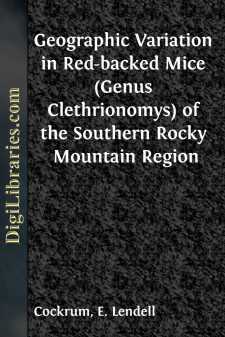Categories
- Antiques & Collectibles 13
- Architecture 36
- Art 48
- Bibles 22
- Biography & Autobiography 813
- Body, Mind & Spirit 142
- Business & Economics 28
- Children's Books 17
- Children's Fiction 14
- Computers 4
- Cooking 94
- Crafts & Hobbies 4
- Drama 346
- Education 46
- Family & Relationships 57
- Fiction 11829
- Games 19
- Gardening 17
- Health & Fitness 34
- History 1377
- House & Home 1
- Humor 147
- Juvenile Fiction 1873
- Juvenile Nonfiction 202
- Language Arts & Disciplines 88
- Law 16
- Literary Collections 686
- Literary Criticism 179
- Mathematics 13
- Medical 41
- Music 40
- Nature 179
- Non-Classifiable 1768
- Performing Arts 7
- Periodicals 1453
- Philosophy 64
- Photography 2
- Poetry 896
- Political Science 203
- Psychology 42
- Reference 154
- Religion 513
- Science 126
- Self-Help 84
- Social Science 81
- Sports & Recreation 34
- Study Aids 3
- Technology & Engineering 59
- Transportation 23
- Travel 463
- True Crime 29
Geographic Variation in Red-backed Mice (Genus Clethrionomys) of the Southern Rocky Mountain Region
Description:
Excerpt
In the course of the preparation of a synopsis of the North American terrestrial microtines by one of us (Cockrum), and the completion of a Master's thesis on the geographical variation of the red-backed mice of Wyoming by the other (Fitch) we had occasion to study the red-backed mice of the southern Rocky Mountain region (see figure 1). Results of these studies are the recognition of two heretofore unnamed subspecies of the red-backed mouse in the southern Rocky Mountain region, and a clarification of the taxonomic status of two additional kinds.
Clethrionomys gapperi galei(Merriam)
1890. Evotomys galei Merriam, N. Amer. Fauna, 4:23, October 8.
1931. Clethrionomys gapperi galei, Hall, Univ. California Publ. Zool., 37:6, April 10.
1897. Evotomys gapperi galei, Bailey, Proc. Biol. Soc. Washington, 11:126, May 13.
Type locality.--Ward, 9500 feet, Boulder County, Colorado.
Range.--The Rocky Mountains of extreme southern Alberta, Montana, northwestern and southern Wyoming, and north and central Colorado.
Remarks.--C. g. galei, with the largest geographic range of any of the Rocky Mountain subspecies, is also the most variable. Three principal areas of geographic variation were found. These areas are: The mountains of north-central Colorado and southern Wyoming (this area includes the type locality); the Big Horn area probably northwest into Montana (no adult specimens from Montana or Alberta examined); and the Teton area which includes the mountains east and southeast of Yellowstone National Park. Specimens from these areas have noticeable differences in pelage, but no constant cranial differentiation could be detected. Specimens from the Medicine Bow Mountains of southern Wyoming have a more reddish dorsal stripe, and more buff and less gray on the sides than either of the northern geographic variants. The dorsal stripe continues farther anteriorly and is better defined through its entire length. There are fewer differences between the two northern geographic variants than between either one of them and the southern variant. Specimens from the Teton Mountains, however, have grayer sides, and the outer margin of the ear is tipped with chestnut (little or no chestnut shows on the ears of the specimens from the Big Horn Mountains); the dorsal stripe is less distinct (with slightly more gray throughout) than in either of the other geographic variants of the one subspecies.
Three specimens (two adults) are available from the Little Medicine Range in Converse County (22 miles south and 24.5 miles west of Douglas, 7600 feet), Wyoming. Although red-backed mice probably are found in the mountains of Natrona and Albany counties, the population, in the Little Medicine Range is somewhat isolated. In coloration these mice are lighter than any of the three geographic variants described above; the dorsal stripe is narrower; the sides are more buffy; the dorsal stripe does not project anteriorly beyond the ears as it does in the specimens from the Medicine Bow Mountains; and the face is grayer. These specimens resemble the population in the Big Horn Mountains to the north more than the population in the Medicine Bow Mountains.
The specimens from the Little Medicine Range, the Big Horn Range, and the Tetons are possibly subspecifically distinct from the southern specimens. Examination of specimens now allocated to galei from Montana and Alberta should aid in revealing whether the northern animals are an unnamed subspecies.
Specimens examined.--Total, 167, distributed as follows and unless otherwise stated, in the collection of the University of Kansas Museum of Natural History:
Wyoming: Park County: 28 mi....




